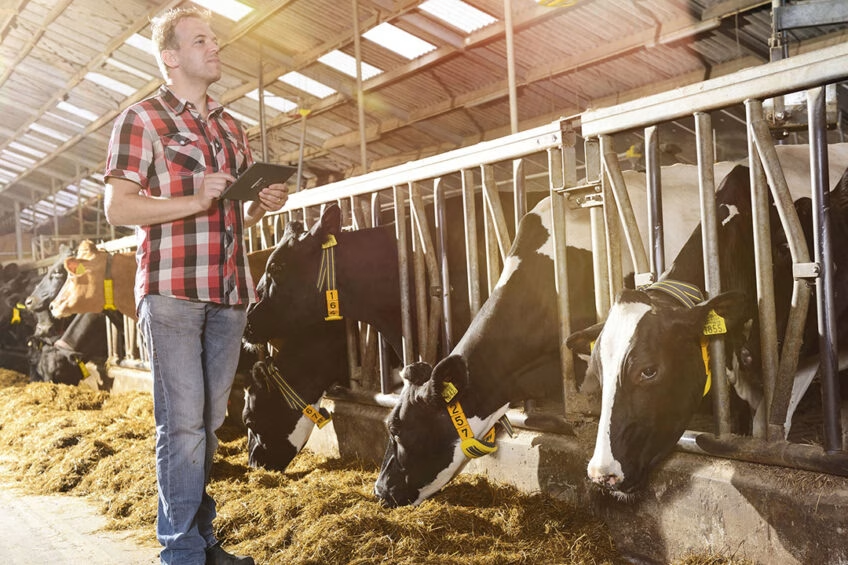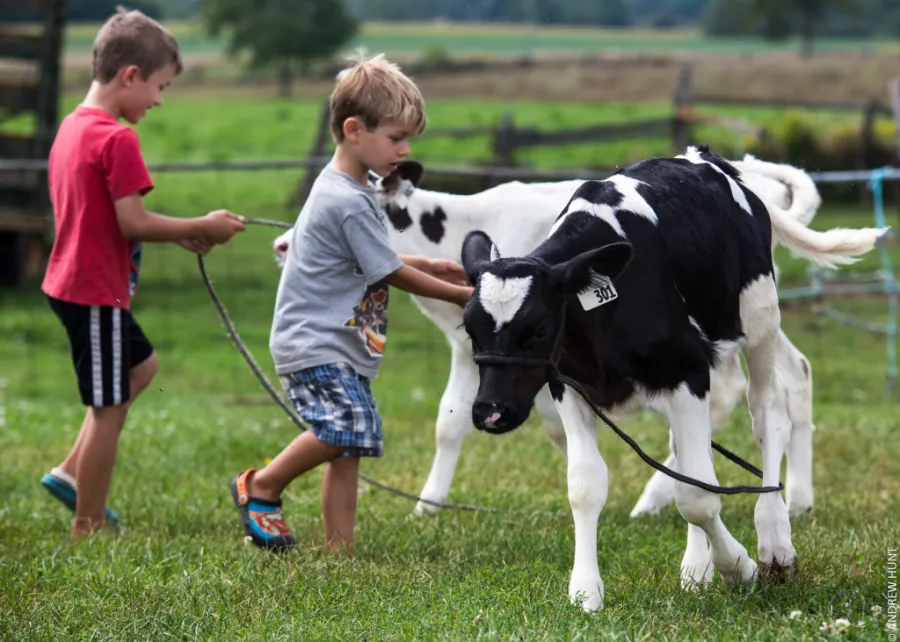Master dairy cattle showmanship with expert tips to impress judges and excel in the ring. Ready to elevate your skills and win champioship ribbons? Discover how now.
Picture yourself stepping into the arena, the excitement and anticipation electric. The spotlight is on you and your pristine dairy calf, ready to wow the judges. This is dairy cattle showmanship—where every detail matters. Showmanship isn’t just a parade; it’s a skilled dance between handler and animal. It’s a testament to the hard work and expertise in livestock farming. Whether a beginner or a pro, honing your skills improves cattle presentation and boosts your show results. Mastering showmanship elevates your cattle and enhances your chance of winning that blue ribbon. Good showmanship displays the animal’s quality and the handler’s dedication. Great showmanship makes it look effortless.
Understanding the Basics of Dairy Cattle Showmanship: Paving the Way for Success in the Show Ring
Understanding the basics of dairy cattle showmanship sets you up for success in the show ring. Here are some key points to grasp:
- Importance of First Impressions: First impressions in the show ring matter. Walk in confidently, showcasing your diligence and dedication through your and your animal’s demeanor.
- Role of the Handler: Your job as a handler is to present your cow optimally. Smooth and deliberate movements reflect your practice. Keep the animal calm and poised throughout.
- Basic Expectations in the Show Ring: Follow show ring etiquette. Move at the judge’s pace and stay aware of your surroundings. Maintain your cow’s natural stance and practice proper techniques for the best presentation. Remember, the judge is not just a spectator but a key player in the show ring. Their observations and decisions can significantly impact your performance, so it’s essential to understand their role and how to best present your cattle to them.
Master these basics to set the stage for a refined and successful showmanship experience. Your effort and dedication will shine through in your performance.
Understanding and Adhering to the Rules and Etiquette of the Show Ring: Your Path to Preparedness and Confidence
Understanding and adhering to the rules and etiquette of the show ring is essential for any dairy cattle exhibitor. These guidelines ensure a fair and organized event, allowing everyone to compete on an even playing field. Like a basketball player, you must follow game rules and comply with show protocols to avoid infractions that could impact your standing.
- Know the Rules: Familiarize yourself with the specific rules of the show. Each event may have slight variations, so read the rulebook and clarify any doubts beforehand. This preparation will help you avoid mistakes and ensure your demeanor in the ring is confident and compliant.
- Respect Fellow Competitors: Respect other exhibitors by maintaining proper distances, not obstructing their view, and avoiding behavior that could distract or disadvantage them. Mutual respect creates a positive environment and fosters camaraderie, regardless of the outcome.
- Demonstrate Good Sportsmanship: The Key to Respectful and Considerate Competition
Following these rules and maintaining respect and sportsmanship: The Path to Integral and Respectful Showmanship
Key Preparation Steps for Success in Dairy Cattle Showmanship
Meticulous preparation is essential before entering the show ring. Grooming, feeding, and training your dairy cattle enhance their appearance and performance.
- Start with grooming. Regular grooming makes your cattle look their best. Use proper brushes, trim hooves for comfort, and focus on cleanliness, especially around the udder and ears. A well-groomed cow stands out and shows your attention to detail.
- Feeding is equally essential. Maintain a balanced diet to promote health and showcase the cow’s physique. Avoid last-minute diet changes to prevent digestive issues. Ensure proper hydration to keep them energetic and alert.
- Training your cattle to respond to basic commands and handle show ring pressures is crucial—practice leading, standing, and turning for fluid movements. Regular practice builds your cattle’s confidence and familiarity with the show environment.
- Finally, expose them to the show setting. Simulate the show experience at home with sights and sounds they might encounter, such as applause and other animals. This reduces anxiety and allows for consistent performance.
These steps improve your cattle’s readiness and build a trusting relationship, setting the foundation for show ring success.
Mastering Presentation Techniques for Dairy Cattle Showmanship
Presentation is key in dairy cattle showmanship. First, stand confidently with a straight back and squared shoulders. This shows control and professionalism, which judges appreciate.
Position yourself on the left side of your animal, staying alert and ready to guide her smoothly. Ensure the judge has an unobstructed view of her best features.
Movement should be fluid and purposeful. Practice walking your cattle consistently, avoiding sudden movements to keep her calm. Your demeanor greatly influences the judge’s perception.
Make occasional eye contact with the judges to show your awareness and confidence. This builds a connection and shows you’re attentive and ready.
To keep your cattle calm, handle her before the show to establish trust. Use gentle, consistent cues to guide her behavior. A secure animal remains more composed in the ring.
Presenting your cattle effectively showcases the harmony between you and your animal. You can leave a lasting impression on the judges with the right approach.
Handling Challenges in the Show Ring: Preparation and Calm Demeanor Are Key
Handling challenges in the show ring requires preparation and staying calm. If your animal acts up, take a deep breath and gently guide her back into position. A natural, focused pose can convey a winning attitude and keep you both on track.
Unexpected distractions like sudden noises can be tricky. Practice with these distractions at home so you and your cattle are ready for anything. The more prepared you are, the easier it is to handle surprises.
Stay calm under pressure. Think of yourself as a player on a court; keeping emotions in check helps you stay focused. Judges are watching how well you manage these situations, not just your cattle. Your calm and composed demeanor can reassure your animal and demonstrate your professionalism to the judges, potentially turning a challenging situation into a winning one.
Visualize success to manage stress. Picture you and your animal performing flawlessly, which can help keep anxiety at bay. The more you practice and stay positive, the better you’ll handle the show ring’s unpredictability.
Attention to Detail: The Fine Line Between Good and Great in Dairy Cattle Showmanship
Attention to detail is key in dairy cattle showmanship. Cleanliness is crucial—ensure your cattle are impeccably groomed with trimmed hooves and a well-brushed coat. A sparkling animal shows your dedication and respect for the event.
Grooming your dairy cattle is a fundamental step in preparing for showmanship. Proper grooming not only enhances the appearance of your cattle but also demonstrates your attention to detail and dedication to the judges. Here’s a practical checklist to ensure you don’t miss any critical grooming tasks:
- Start with Cleanliness: Ensure your cattle are thoroughly washed and free from dirt, dust, and manure.
- Clip Appropriately: Use clippers to trim excess hair, paying close attention to the legs, udder, and tail.
- Hoof Care: Trim and clean hooves to prevent any discomfort or unsightly appearance.
- Brushing and Combing: Regularly brush your cattle to keep their coat smooth and shiny. Use a comb for finer detailing.
- Condition the Coat: Apply a conditioner to enhance the coat’s natural sheen and manageability.
- Ears and Eyes Care: Clean the ears and eyes gently to remove any debris and ensure they are bright and clear.
- Tail Head and Switch: Pay special attention to the tail, ensuring it is fluffed and tang-free.
- Final Touch-Up: Just before entering the show ring, do a quick final inspection and touch up any areas that need it.
Wear clean, well-fitted clothing that allows for easy movement. Your professional appearance can make a great impression on the judges.
Handle your cattle with gentle, precise signals. Avoid roughness and exaggerated motions: judges value control and a calm demeanor. Your smooth interactions will leave a lasting impression.
The Judge’s Eye: Key Traits That Set Top Exhibitors Apart in the Show Ring
When you enter the show ring, remember that judges have a keen eye and lots of experience. They look for a handler who makes the animal appear relaxed and showcases its best traits. Following show ring rules meticulously is vital, much like in sports. Simple mistakes, like improper positioning or lack of attention, can cost you points. Judges also favor handlers who maintain the animal’s natural beauty without overusing grooming products. You can enhance your showmanship skills by staying composed, following the rules, and highlighting your animal’s natural look.
Advanced Strategies for Standing Out in Dairy Cattle Showmanship: Elevate Your Skills and Performance
To stand out in dairy cattle showmanship, you must hone advanced skills beyond the basics. Mastering these subtler techniques can give you that extra edge.
- Precision in Handling: Guide your cattle gently yet firmly, ensuring smooth transitions and movements. Use controlled gestures to direct your animal, making it look effortless to the judges.
- Natural Stance: Your posture matters. Appear confident yet relaxed, showcasing control without being rigid.
- Minimize Distractions: Maintain a calm environment and be aware of other competitors. Fewer distractions mean better performance.
- Perfect Timing: Synchronize your steps with your animal’s movements for a polished presentation. Practice is essential here.
- Consistent Condition: Keep your cattle in peak condition through regular grooming, feeding, and health monitoring. This highlights your dedication and care.
- Engage Judges: Subtly make eye contact and acknowledge the judges. This conveys confidence without being too obvious.
- Attention to Detail: Focus on minor aspects like cleanliness, attire fit, and demeanor. These small details collectively create a standout performance.
Refining these techniques will enhance your skills and improve your cattle’s presentation. Remember, mastery comes from continuous learning and practice. Stay dedicated and keep evolving.
The Bottom Line
Success in dairy cattle showmanship starts with leading your heifer correctly and maintaining confidence. Adhere to the show ring rules and refine your preparation and presentation techniques to shine. Approach challenges calmly and focus on details, like the heifer’s legs and under the dewclaws. Practice regularly and seek feedback from experienced peers and judges. Remember, showmanship is about dedication and passion. It’s not just about winning but enjoying the experience and building bonds. Practice diligently, and let your efforts shine in the ring!
Key Takeaways:
- Understanding and adhering to the rules and etiquette of the show ring is critical for success.
- Proper preparation, including thorough grooming and training, sets a strong foundation.
- Mastering presentation techniques can significantly enhance your performance in the ring.
- Staying calm and composed when dealing with challenges in the show ring is essential for maintaining control.
- Paying attention to the finer details can make a meaningful difference in your showmanship results.
- Top exhibitors possess traits that judges consistently look for, such as confidence, poise, and attentiveness.
- Advanced strategies and continuous improvement can elevate your skills and help you stand out.
Summary:
Dairy cattle showmanship is a skill that involves the interaction between the handler and the animal, showcasing the quality of the animal and the handler’s dedication. It is not just a parade but a skilled dance between the handler and the animal, highlighting the hard work and expertise in livestock farming. Mastering showmanship elevates the cattle and enhances the chance of winning the blue ribbon. First impressions are crucial, so walk in confidently, showcasing your diligence and dedication through your and your animal’s demeanor. Follow show ring etiquette, move at the judge’s pace, and stay aware of your surroundings. Adhering to the rules and etiquette of the show ring is essential for any dairy cattle exhibitor. Key preparation steps include grooming, feeding, and training your cattle. Exposure to the show setting at home reduces anxiety and allows consistent performance.
















